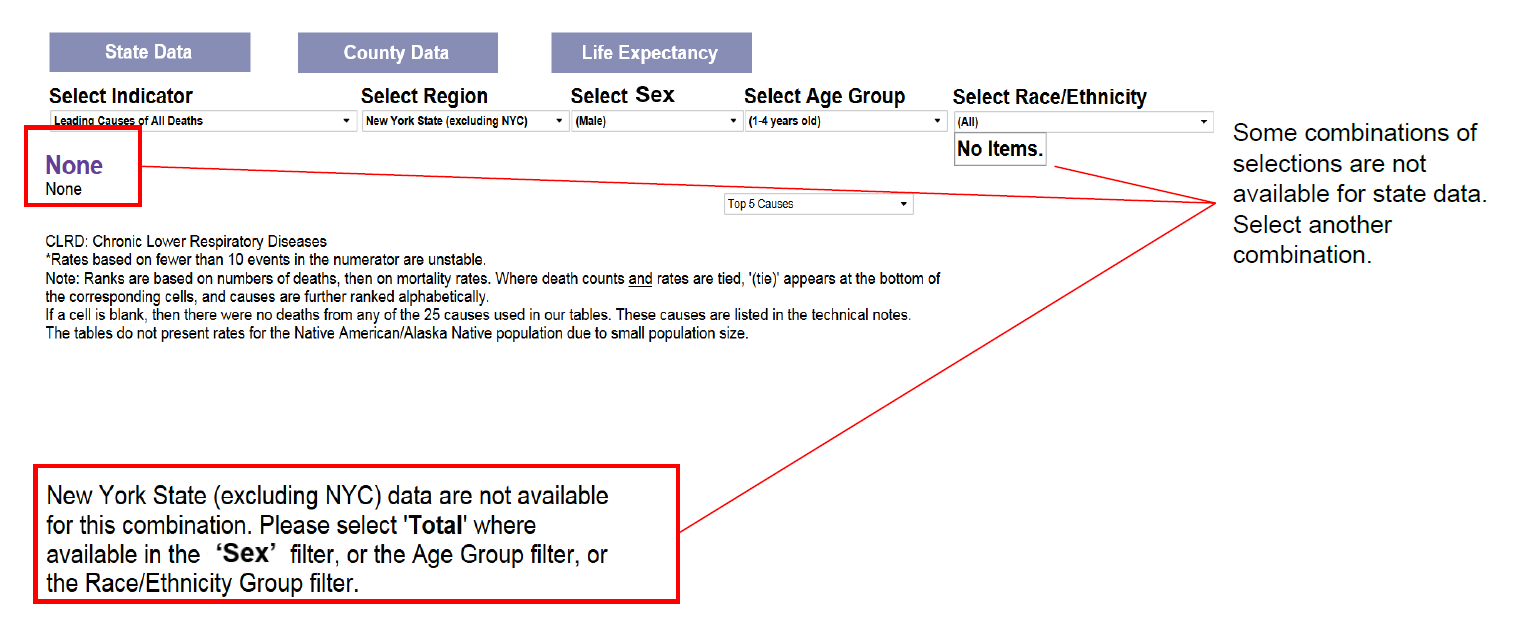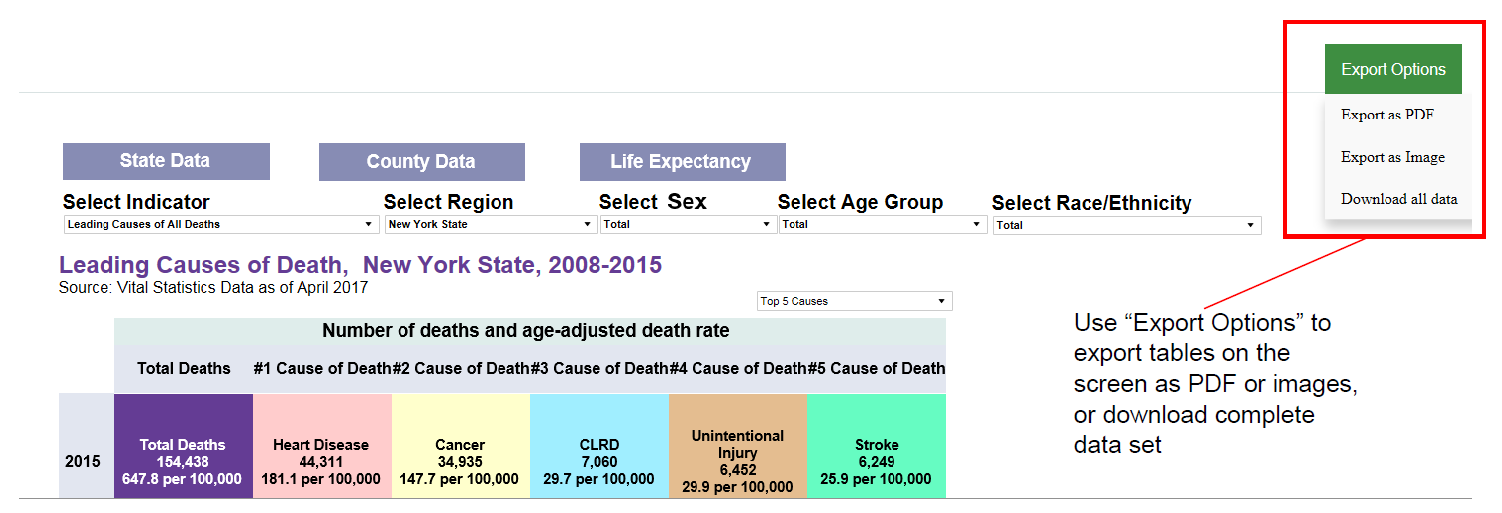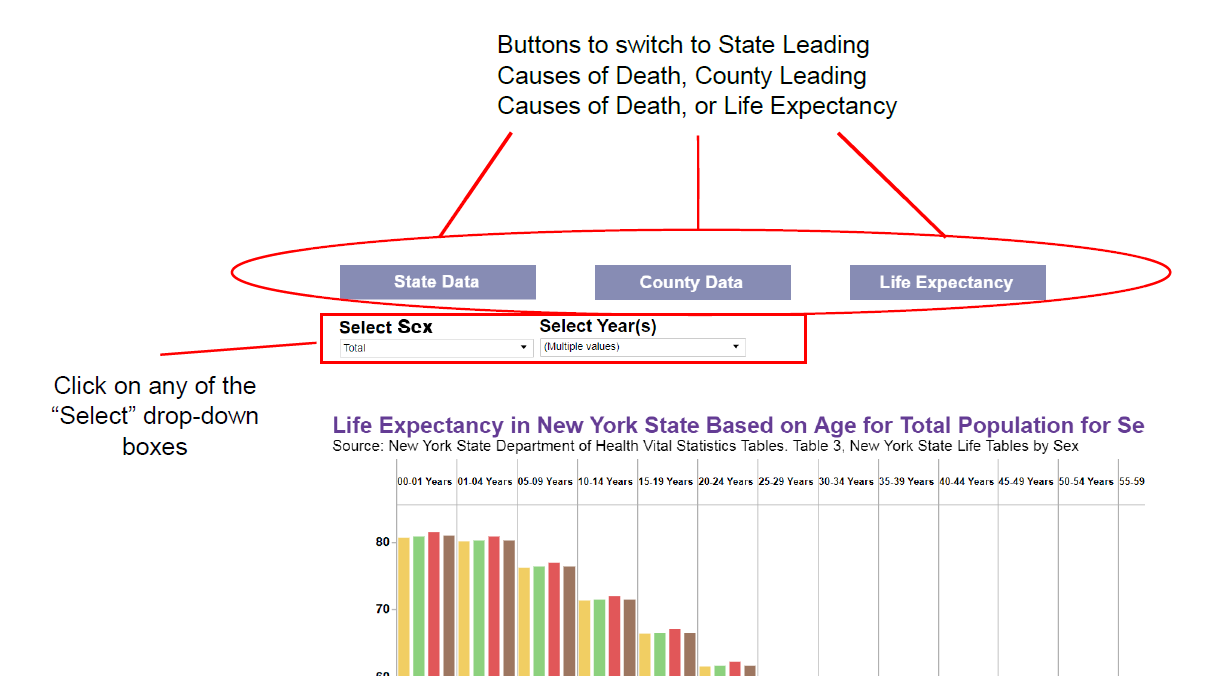Reports
Leading Causes of All Deaths and Leading Causes of Premature Deaths (Death before age 75)
- State and regional reports
- These tables present ten years of number of deaths and death rates for the top causes of all deaths and premature deaths in New York State, New York City and New York State excluding New York City, up to the most recent year with available data, by selected characteristics such as sex, age, and race/ethnicity.
- County reports
- These tables present ten years of number of deaths and death rates for the top causes of all deaths and premature deaths in 62 counties of New York State by sex, up to the most recent year with available data.
Life Expectancy
- Life Expectancy by Sex
- The table presents ten-year trends of life expectancy at specified ages in New York State up to the most recent year with available data.
Technical Notes
- About New York State Leading Causes of Death
-
Deaths
The causes of death reported in these pages are the underlying causes classified according to the tenth revision of the International Classification of Diseases (ICD, 10th revision), adopted by New York State in 1999.
Infant (less than 1 year of age) mortality rates published in this report are based on all live births regardless of birth weight or gestation. No attempt was made to account for the viability of the infant at birth. These rates for a specific year are based on deaths and live births that occurred during that year.
When tabulating deaths by place of death, "other institution" is defined as state institution, Veterans Administration facility, hospice, federal institution, health-related facility or home for the aged.
Total deaths is the count of all deaths, including records with race, age or sex “Not Stated".
Population Estimates
All population estimates are for the year indicated in these tables and are from the NCHS released estimates of "Bridged Race Vintage files", which are released annually. Estimates by race are for single races (e.g., White, Black or African American, American Indian or Alaska Native, and Asian or Pacific Islander). The data on Spanish ethnicity is consistent over the years.
The 2018 population estimates are used to calculate rates for 2019 and 2020.
Crude Death Rate
The crude death rate is the number of deaths per 100,000 population.
Age-adjusted Death Rate (Direct Method)
Death rate in a group is calculated as a weighted average of the age specific death rate of the same group. The system of weights is the age distribution of a population called the standard population. The percentages were age-adjusted to the U.S. 2000 standard population using appropriate age distributions. The tables do not present rates for the Native American/Alaska Native population due to small population size.
Source
New York State Department of Health - Office of Quality and Patient Safety - Division of Information and Statistics - Bureau of Health Informatics - Vital Statistics Unit a
Premature Causes of Death
The term Premature Causes of Death is used as a measure of deaths that occurred prior to individuals reaching the age of 75 years. Seventy-five years of age is the national standard that is used for a comparison basis.
Information, Programs and Prevention Strategies
New York State's Prevention Agenda 2019-2024: New York State's Health Improvement Plan is the blueprint for state and local action to improve the health of New Yorkers in five priority areas and to reduce health disparities for racial, ethnic, disability, socioeconomic and other groups who experience them. Recommended evidence-based programs, policies and practices have been identified for each action plan.
Data Notes
a Vital Records (Vital Statistics): Vital Event Registration:
New York State consists of two registration areas, New York City and New York State Exclusive of New York City (also referred as Rest of State). New York City (NYC) includes the five counties of Bronx, Kings (Brooklyn), New York (Manhattan), Queens and Richmond (Staten Island); the remaining 57 counties comprise New York State Exclusive of New York City. The Bureau of Vital Records, New York State Department of Health (NYSDOH), processes data from live birth, death, fetal death and marriage certificates recorded in New York State Exclusive of New York City. Through a cooperative agreement, the New York State Department of Health receives data on live births, deaths, fetal deaths and marriages recorded in New York City from the New York City Department of Health and Mental Hygiene (NYCDOHMH) and on live births and deaths recorded outside of New York State to residents of New York State from other states and Canada.
Vital Event indicators for NYC geographical areas reported by NYSDOH and NYCDOHMH may be different since the former may include all NYC residents' events regardless of where they occurred and the latter reports only events to NYC residents that occurred in NYC. The indicators may also differ due to timing and/or completeness of data.
The counts of births and deaths may be influenced by specific reporting issues each year. The specific issues are reported in the NYSDOH Annual Vital Statistics Tables, in the Report Measures section of the Technical Notes.
All the vital statistics presented in this report are based on the county/borough of residence. - About New York State Life Expectancy
-
Deaths
New York State Public Health Law does not require that death be pronounced by a physician. Unless there is a local law that requires otherwise, anyone may make the pronouncement of death. However, this decision is more likely to fall upon emergency medical technicians, police, fire fighters and other emergency personnel. The pronouncement may even be implied by the decision to call a funeral director or coroner/medical examiner instead of an ambulance. NYS PHL 4140 requires that a death certificate be filed within 72 hours after death, or the finding of the body, by a funeral director or undertaker licensed and currently registered by the New York State Department of Health.
Population Estimates
Population Estimates (2008 for example) - All population estimates are for the year indicated in these tables and are derived from the NCHS released estimates of "Bridged Race Vintage 2008", etc. which are consistent with the Bureau of the Census estimates from "Vintage 2008" (released in the Summer, 2009). Census race categories are White, Black or African American, American Indian or Alaska Native, and Asian or Pacific Islander. The data on Spanish ethnicity is consistent over the years.
Life Tables
Life Tables (2014 for example): Table three from the Vital Statistics Annual Reports presents life expectancies for the total, male and female populations of New York State. The life table consists of seven columns. The life expectancy in the tables and charts of the Leading Causes of Death pages are taken from the seventh column of the Vital Statistics pages and are defined as follows: This is the expectation of life at the age at the beginning of the age interval.
Data Source
New York State Department of Health - Office of Quality and Patient Safety - Division of Information and Statistics - Bureau of Health Informatics - Vital Statistics Unit
- About Death Grouping Color Chart
-
Causes of Death and Assigned Color ICD-10 Coding HIV/AIDS ICD-10:
B20-B24Alzheimer's Disease ICD-10:
G30Arteriosclerosis ICD-10:
I70Birth Defects ICD-10:
Q00-Q99Cerebrovascular Disease ICD-10:
I60-I69Chronic Lower Respiratory Diseases (CLRD) ICD-10:
J40-J47COVID-19 ICD-10:
U07.1Diabetes (Diabetes Mellitus) ICD-10:
E10-E14Gastritis, Enteritis, Colitis, Diverticulitis ICD-10:
K29,K50-K52, K57Heart Disease ICD-10:
I00-I09,I11,I13,I20-I51Hypertension with or without Renal Disease ICD-10:
I10,I12Homicide and Legal Intervention ICD-10:
X85-Y09, Y35, Y87.1, Y89.0Kidney Disease and Diseases of Urinary Tract ICD-10:
N17-N19, N25-N27, N00-N07Liver Disease and Cirrhosis ICD-10:
K70, K73-K74Malignant Neoplasms (Cancer) ICD-10:
C00-C97Other Diseases of the Circulatory System ICD-10:
I71-I78,I80-I99Parkinson's Disease ICD-10:
G20, G21Perinatal Period Condition ICD-10:
P00-P96Pneumonia and Influenza ICD-10:
J10-J18Pneumonitis Due to Solids and Liquids ICD-10:
J69Pregnancy and Childbirth Related ICD-10:
O00-O99Septicemia ICD-10:
A40-A41SIDS ICD-10:
R95Suicide ICD-10:
X60-X84,Y87.0Unintentional Injury ICD-10:
V01-X59,Y85-Y86
User's Guide and Useful Links
Webinar slides on Leading Causes of Death data application (PDF)
Webinar recording on Leading Causes of Death data application (Video)
- How to use the State Report and the County Report
-
State and county reports show slightly different drop-down options.





For further explanation and detail, see User's Guide.
- How to use the Life Expectancy Report
-


For further explanation and detail, see User's Guide.
- Where can I find more county and sub-county statistics?
-
- Prevention Agenda Dashboard
- Asthma in New York
- Community Health Indicator Reports (CHIRS)
- County Health Indicators by Race/Ethnicity (CHIRE)
- County/ZIP Code Perinatal Data Profile
- Opioid-related Data in New York State
- Maternal and Child Health (MCH) Dashboard
- Communicable Disease Annual Reports
- New York State Cancer Registry
- Vital Statistics
- Expanded Behavioral Risk Factor Surveillance System
- Sexually Transmitted Diseases Data and Statistics
- Environmental Public Health Tracker
Contact Us
If you have questions about the reports, please contact:
Public Health Information Group at: phiginfo@health.ny.gov